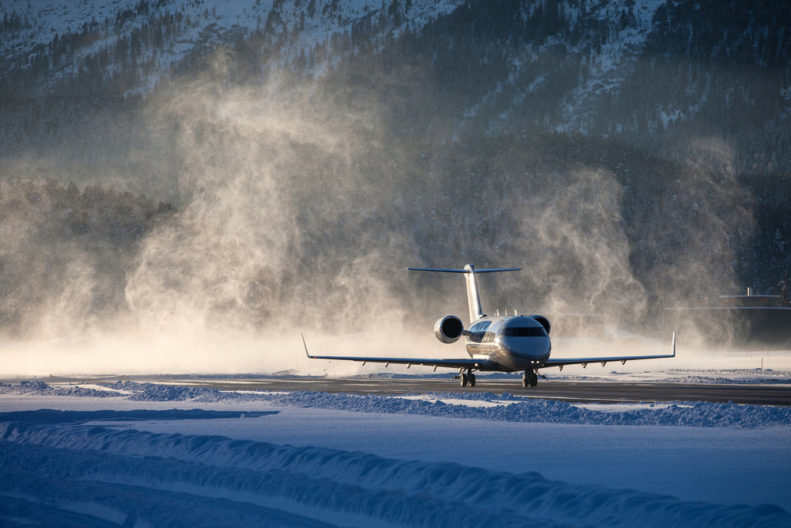
Tips to Prep You and Your Aircraft for Cold Winter Flying
Snow, ice, and all kinds of winter weather is here, at least if you live in the colder regions of the northern hemisphere. When the temperatures drop well below freezing, there are some extra precautions that you may want to take to help make sure your aircraft are operating safely and efficiently. Keep some of the tips below in mind when flying this winter. You never know when Jack Frost will surprise you with a sudden cold snap that you weren’t fully expecting.
Preheat Your Engine
Especially for you piston drivers, it’s a good idea to think about preheating when temperatures drop below freezing (32°F/0°C). Manufacturer-listed minimum temperatures for preheating are often listed at lower than the freezing point, but it’s good to error on the side of caution. Use a slow, gentle heat for a few hours before your flight, rather than one sudden high heat burst just before take-off. This will better help the engine warm up all the way through.
Consider Covering Your Engine and Wings
Protect your aircraft’s engine and wings from bitterly cold temperature by using a quality covers on those cold nights. Combined with preheating, this will really help keep your engine performing well even in the most frigid conditions. The wing covers help to reduce any ice or snow buildup that may occur. You may also consider these during the day too if you’ll be grounded out in the open for more than a few hours in arctic conditions.
Have Cold Weather Attire Available
Even if you don’t plan on wearing bulky cold gear, it’s a good idea to keep some with you. To start, being properly dressed helps to make sure you don’t pull a “quickrun” preflight inspection while out in the cold that could potentially be dangerous. You never want to cut corners on a preflight inspection, but this is especially important during the winter months. Additionally, even if your flight plan has you traveling only between warm locations, you never know when an emergency might have you land in far chillier conditions than you were expecting.
Let that Landing Gear Hang Out a Bit Longer
A slushy runway can fill up wheel fairings with ice and snow and once you ascend into colder air, it can really harden around the landing gear. Let those wheels and tires hang a bit longer after take-off to help them spin off excess ice and slush before pulling them in for retraction.
The winter season can offer some beautiful flying conditions and cold, dense air means awesome performance. Just keep a few safety precautions in mind and you’ll be good to go until the warmer springtime temps come around again.
Snow, ice, and all kinds of winter weather is here, at least if you live in the colder regions of the northern hemisphere. When the temperatures drop well below freezing, there are some extra precautions that you may want to take to help make sure your aircraft are operating safely and efficiently. Keep some of the tips below in mind when flying this winter. You never know when Jack Frost will surprise you with a sudden cold snap that you weren’t fully expecting.
Preheat Your Engine
Especially for you piston drivers, it’s a good idea to think about preheating when temperatures drop below freezing (32°F/0°C). Manufacturer-listed minimum temperatures for preheating are often listed at lower than the freezing point, but it’s good to error on the side of caution. Use a slow, gentle heat for a few hours before your flight, rather than one sudden high heat burst just before take-off. This will better help the engine warm up all the way through.
Consider Covering Your Engine and Wings
Protect your aircraft’s engine and wings from bitterly cold temperature by using a quality covers on those cold nights. Combined with preheating, this will really help keep your engine performing well even in the most frigid conditions. The wing covers help to reduce any ice or snow buildup that may occur. You may also consider these during the day too if you’ll be grounded out in the open for more than a few hours in arctic conditions.
Have Cold Weather Attire Available
Even if you don’t plan on wearing bulky cold gear, it’s a good idea to keep some with you. To start, being properly dressed helps to make sure you don’t pull a “quickrun” preflight inspection while out in the cold that could potentially be dangerous. You never want to cut corners on a preflight inspection, but this is especially important during the winter months. Additionally, even if your flight plan has you traveling only between warm locations, you never know when an emergency might have you land in far chillier conditions than you were expecting.
Let that Landing Gear Hang Out a Bit Longer
A slushy runway can fill up wheel fairings with ice and snow and once you ascend into colder air, it can really harden around the landing gear. Let those wheels and tires hang a bit longer after take-off to help them spin off excess ice and slush before pulling them in for retraction.
The winter season can offer some beautiful flying conditions and cold, dense air means awesome performance. Just keep a few safety precautions in mind and you’ll be good to go until the warmer springtime temps come around again.